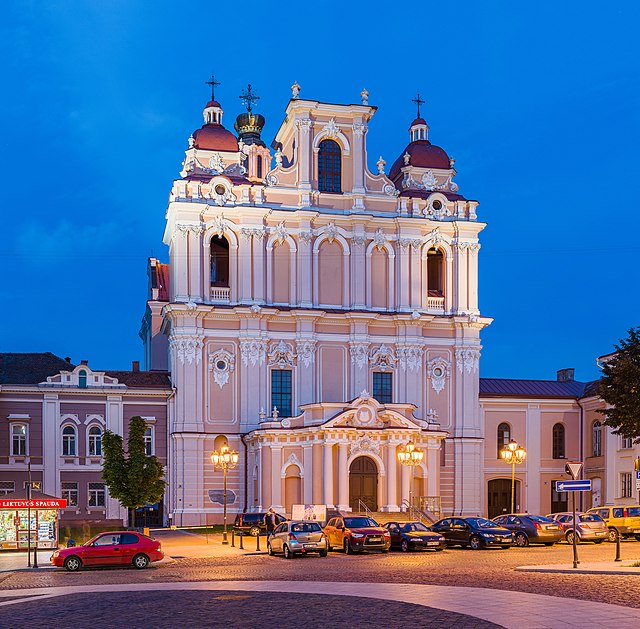Vilnian Baroque
From Wikipedia, the free encyclopedia
The Vilnian Baroque (Lithuanian: Vilnietiškas barokas, Polish: barok wileński) or the School of Vilnius Baroque (Lithuanian: Vilniaus baroko mokykla, Polish: wileńska szkoła baroku) is a name of late Baroque architecture style in Catholic church architecture of the Grand Duchy of Lithuania, which expanded well into Greek Catholic church architecture on territories covered by the Union of Brest.[1][2][3] The style was formed by alumnus of the Catholic Jesuits' Vilnius University. Most preserved buildings in this style are in Vilnius.[4][5][6][3][7]

The architect Johann Christoph Glaubitz is considered one of the founders of Vilnian Baroque.[8] Working on the restoration of churches in Vilnius, he was often inspired by contemporary buildings of Austria and Bavaria. Polish churches created by Paolo Fontana are also made in Vilnian Baroque style. Although being predominantly Catholic style of architecture, Vilnian Baroque was also popular among the Uniates, which gave the style its second name ‘Uniate Baroque’.[9] Another famous architect Thomas Zebrowski also designed and supervised constructions of Vilnian Baroque churches in Lithuania and Belarus.[10]
Vilnian Baroque is characterized by an upward striving outlook, two towers, symmetry, and the overall lightness of shapes. In this regard the style is opposed to the so-called[by whom?] Sarmatian[dubious – discuss] that was widespread in the Grand Duchy of Lithuania in the late XVII — early XVIII centuries.[11][12][2][3] Other features of the Vilnian Baroque include differently decorated compartments, undulation of cornices and walls, decorativeness in bright colors, and multi-colored marble and stucco altars in the interiors.[12][3][13]
Monuments of Vilnian Baroque by country
Lithuania



- Vilnius
- Church of the Blessed Virgin Mary of Consolation in Vilnius;
- Church of St. Catherine;
- Church of St. Casimir;
- Church of Ascension in Vilnius;
- Church of Holy Trinity in Trinapolis;
- Church of the Discovery of the Holy Cross
- Church of Jesus the Redeemer;
- Church of the Holy Cross in Vilnius;
- Church of St. Raphael the Archangel;
- Church of All Saints;
- Dominican Church of the Holy Spirit;
- Church of St. Johns;
- Church of the Sacred Heart of Jesus in Vilnius;
- Church of St. Philip and St. Jacob;
- Orthodox Church of the Holy Spirit;
- Orthodox Church of St. Nicholas;
- Church of St. George in Vilnius;
- Gates of the Monastery of the Holy Trinity;
- Church of St. Peter and St. Paul;
- Church of St. Theresa.
- Kaunas
- Kražiai
- Church of the Immaculate Conception of Saint Virgin Mary.[10]
Belarus

- Saint Sophia Cathedral in Polotsk;
- Church of Protection of the Holy Virgin in Talačyn;
- Zhyrovichy Monastery;
- Church of the Assumption in Viciebsk;
- Cathedral of the Nativity of the Virgin, Hlybokaye
Ukraine
Latvia
- Basilica of the Assumption in Aglona;
- St Dominic's Church in Pasiene;
- Jesuit Church in Ilūkste.
References
Sources
Wikiwand - on
Seamless Wikipedia browsing. On steroids.
